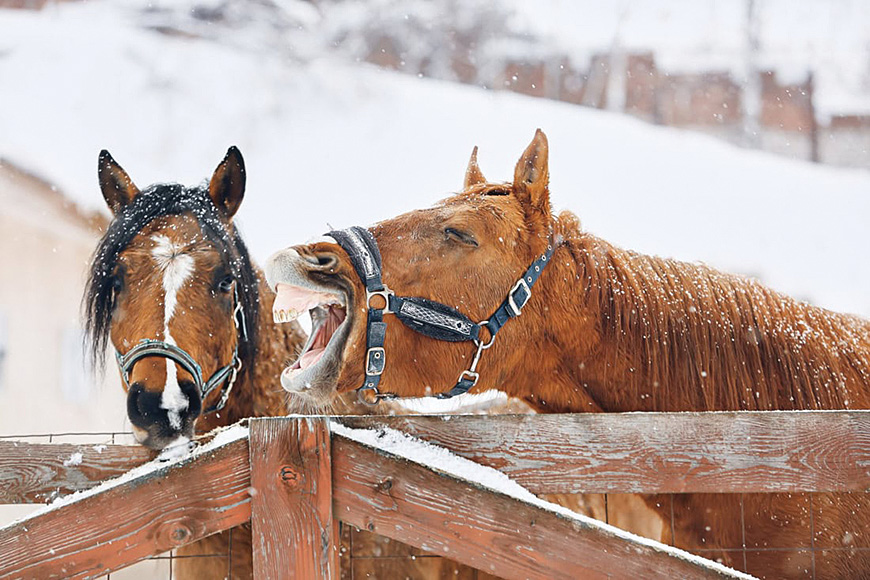
Winter Care Tips & Warning Signs
Written by: Camryn McNeill, B.B.R.M.
Reviewed by: Dr. Christine Latham, Ph.D.
Veterinary Review: Dr. Madison Ricard, DVM, PhD, DACVP
As Canada’s leader in equine nutrition, Mad Barn thanks The Rider for featuring this story. To read the full version of the article, visit https://madbarn.ca/frostbite-and-hypothermia-in-horses/.
Exposure to extreme low temperatures can lead to serious health concerns like hypothermia and frostbite in horses. Frostbite usually affects the extremities, while hypothermia is a systemic condition caused by a dangerous drop in core body temperature. Left untreated, both hypothermia and frostbite can cause severe tissue damage, compromise immune function, and even result in death. However, proactive management strategies can keep horses safe even in extreme cold weather.
 Hypothermia
Hypothermia
Hypothermia occurs when a horse’s core body temperature drops below the normal range (approximately 99°F to 101°F or 37°C to 38.3°C), typically due to prolonged exposure to cold, wet, or windy conditions.
There are two main types of hypothermia in horses:
• Accidental hypothermia: Occurs when external environmental conditions overwhelm the horse’s ability to regulate its body temperature.
• Pathological hypothermia: Results from internal medical conditions that disrupt the horse’s thermoregulatory system.
Foals are particularly vulnerable to hypothermia, and adult horses are at risk of hypothermia under specific conditions, such as extreme cold, wet conditions, and old age.
Frostbite
Frostbite describes localized freezing of tissues that occurs when horses are exposed to prolonged cold, often combined with wet or windy conditions. It most commonly affects the ears, tail, nose, and legs.
Foals are more likely to develop frostbite in their extremities due to their smaller size, lower fat reserves, and immature temperature regulation systems.
Signs & Symptoms
Hypothermia and frostbite may occur simultaneously or independently, and recognizing their clinical signs is crucial for prompt intervention.
Signs of hypothermia in horses can include:
• Weakness
• Shivering
• Rapid Heart Rate
• Rapid Breathing
• Unresponsiveness
• Reduced Gastrointestinal Sounds
Signs of frostbite in horses typically appear on the ears, tail, muzzle, penis, and legs. The severity and duration of cold exposure can influence the specific clinical signs, which may include:
• Skin Discoloration
• Cold Extremities
• Swelling
• Blisters or Vesicles
• Loss of Sensitivity
• Pain
Treatment
If your horse shows signs of cold stress, contact a veterinarian promptly for an accurate diagnosis and treatment plan. While waiting for professional guidance, consider taking the following steps:
• Move the horse to warm shelter
• Remove wet blankets or bedding
• Offer forage to maintain internal heat production
• Monitor vital signs to identify changes in body temperature
In cases of severe cold stress, prompt veterinary attention is critical to prevent serious complications or permanent damage.
Treating Hypothermia
The primary goals of treatment for equine hypothermia are to warm the horse gradually, monitor vital signs, and provide supportive care.
Move the horse to a dry, warm, sheltered environment, protected from wind, rain, or snow. Remove wet bedding or damp blankets to reduce ongoing heat loss.
It’s important to avoid sudden, extreme changes in temperature to prevent shock. Gradual warming methods may include:
• Layering thick, insulated blankets
• Heating the environment
• Warm IV fluids administered by a veterinarian
• Monitoring rectal temperature, heart rate, and respiratory rate
• Addressing underlying conditions such as sepsis, shock, or hypothyroidism in cases of pathological hypothermia
Treating Frostbite
If one of your horses is showing signs of frostbite, move them to a warm, dry, sheltered environment as soon as possible, protecting affected areas from continued cold exposure. Contact your veterinarian immediately for guidance on properly managing the condition.
Avoid applying direct heat sources, such as hot water or heating pads. Instead, gently warm the frostbitten areas by soaking or rinsing them with lukewarm (not hot) water for approximately 20–30 minutes. This controlled warming helps restore circulation gradually without causing additional injury.
After warming, cover the affected areas with clean, soft bandages or padding to protect against further injury or trauma.
Prevention
Preventing hypothermia and frostbite is key for maintaining horse health in cold, wet conditions. Follow these key strategies to reduce risks:
• Provide Adequate Shelter
• Keep Bedding Dry
• Use Blankets
• Monitor Body Condition.
• Increase Forage Intake
• Limit Exposure to Extreme Cold
• Ensure Hydration
• Check Extremities Regularly
And finally, always work with your veterinarian if one of your horses is showing signs of cold stress. Early intervention is the best way to ensure optimal outcomes, keeping your herd happy and healthy for years to come.  About Camryn McNeill;
About Camryn McNeill;
Cam lives in Ontario, Canada and completed her Bachelor’s of Bio-Resource Management (B.B.R.M.) at the University of Guelph with a specialization in Equine Management. She is interested in horse welfare and understands the importance of a healthy diet for a happy horse. She has over 15 years of horse experience, having worked at lesson barns and racetracks. When she’s not studying, Cam spends the majority of her time hanging out by the lake with her dog or hitting the gym.
Source: MadBarn


